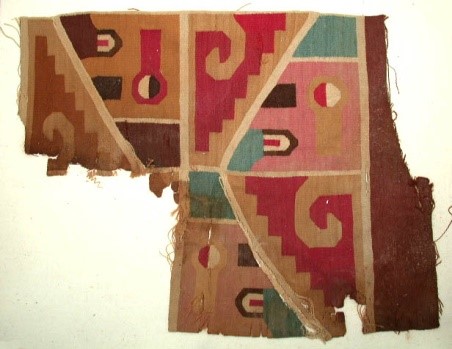In January, I take a trip to Mexico. On the second afternoon I escape from the Commercial Gifts and Accessories Show to visit Mexico City’s Museum of Anthropology. It is set in a woodland park called Chapultepec, or Hill of the Grasshoppers in Nauhatl, one of the original languages of Mexico. The Museum is a two storey building set around a central courtyard, at one end of which is something like a fountain.
But here, the water, rather than shooting upwards, falls from a giant column the height of the building. The carved stone column is a fertilising penis dripping blood, a tree reaching up to the sky, the arching vault of an underground cave – three powerful and ancient images of Mexican identity.
The museum is extraordinary. With all the rich archaeology of Mexico and the many civilisations that were born here, flourished and spread, exchanged ideas, evolved and died, this is truly a museum of anthropology – about people.
The ground floor has a series of halls dedicated to some of the famous peoples from Mexico’s pre-conquest past, the settling of the Americas by migrants from Asia, and the development of settled life from nomadic peoples. From this settlement a series of amazing cultures developed across the region – the Toltecs in the Central Highlands, followed by the Aztecs or Mexica, the Zapotec and Mixtec to the south, the Olmec, Totonac and Huastec to the east on the Caribbean coast, the Maya to the south east, and other peoples of the west and south.
The upper galleries of the museum, occupying equal space, are dedicated to Mexico’s living peoples, languages and cultures, rituals, festivals, costumes, and beliefs.
On my first visit I spend two hours working through just half the displays on the ground floor. I cover tens of thousands of years, from the first peoples who crossed a land bridge from Asia to reach the Americas and worked their way south, leaving traces of their passing at sites such as Las Guitarras in Peru, up to the peoples of Teotihuacan, who built great pyramids 40 km north east of of Mexico city, the so called Temple of the Sun and the Moon.
I linger over Mexican pots repeating many icons of Peruvian art. Not just simple universal motifs like spirals and crosses, but more complex symbols such as the iconic stepped cross or Chakana of pre-hispanic cultures. Its discovery in the excavations of Caral has been proffered as evidence of 5000 year old cultural continuity in the Andean world. But here it is, too, on Mexican pottery.
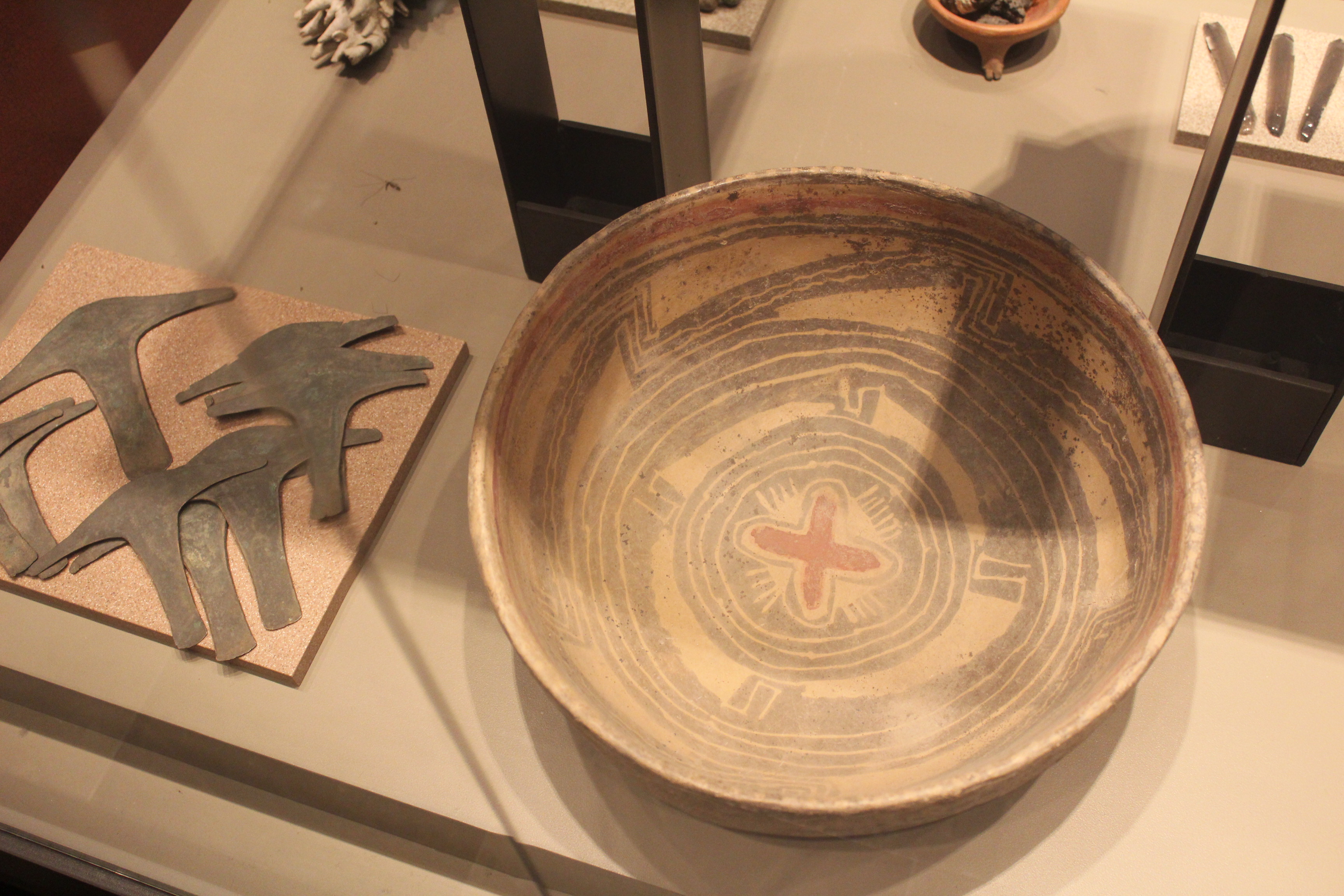
The combination of steps and a wave spiral, classic symbol of the Moche and the Wari, said to represent the mountains and the sea, is repeated here on pots from Guanajuato. A cross enclosed in a frame forms the central design of a Mexica bowl. The symbol is said to be a Mayan glyph representing Venus. But I have seen it before, drawn twice on the river facing panel of the northernmost rock at Cochineros.

After several days working my way through interviews in bad Spanish with vendors of stuffed toys I escape again to visit the city of Teotihuacan, an hour’s bus ride from modern Mexico city. On the way, I take the opportunity to read up about the colonial invasion of Mexico.
Christopher Columbus reached the Caribbean in 1492, and left forty men on what they called Hispaniola, “the spanish island”, between Cuba and Puerto Rico, before returning to Spain to announce the discovery of a new continent.
At the request of the spanish crown, Pope Alexander VI, as God’s representative on Earth, commanded the spanish to “convert the pagans” and declared the lands would be divided between Spain and Portugal. A second expedition of 1200 men on 17 ships in 1493 found the settlement on Hispaniola destroyed, but established new landing points there and in Puerto Rico, and explored Cuba and Jamaica. Ships were sent back to Spain for more men, livestock and arms.
In 1495 the spanish defeated the indigenous Taino of Hispaniola in battle. The island became a power base for the spanish adventurers. African slaves were introduced in 1503, the same year that the Queen of Castille introduced a legalised system of exploiting native labour through encomiendas, grants of labour rights to spanish settlers, the military conquerors.
A year later Hernando Cortes reached the island and received a grant of land and an encomienda, a legal right to use native labour which was for him and his descendants in perpetuity. He took part in the invasion of neighbouring Cuba, where he was given more land and native labour. This was the source of the wealth and power that he used to attack Mexico.
The invasion of the Mexican mainland began in 1519 and within two years, the spanish had overrun the Aztec empire and set about destroying its culture and values.
Settlements were established in Panama, then called Castilla de Oro or “Golden Castille”, in 1510. Pizarro was given cattle and natives by the governor in Panama, and later the positions of mayor and magistrate. Here he gained the wealth and power to launch his invasion of Peru in 1526. That invasion failed, but he did introduce a deadly pandemic. When he returned with a larger invasion force the country was half broken.
Pizarro sailed again to Peru in 1532 and his forces captured and imprisoned the ruling Inca, Atahualpa, ransoming him for a room full of gold and silver. When the ransom was collected they killed him. There followed a bloody civil war between different gang leaders, using native armies as proxies.
The indigenous cultures in Peru and Mexico were replaced with a new order driven by ideas of racial superiority, religious and state power intertwined, and greed for gold. These remain the dominant drivers in Latin American life up to the present day.
When the spanish sailed from Cuba to land on the central American coast in 1519, they found there an ethnically diverse land linked by alliances and tribute. The people wrote books on animal skins, with text in glyphs, they composed poetry, carved stone, calculated astronomical cycles with complex calendars, traded over vast distances, and spoke many languages including Nahuatl, which has given us chocolate, tomato, chili, avocado and tamales, to name a few. They sacrificed in their thousands warriors conquered in battle with other city states, and let their blood flow down the temple steps and fill stone bowls.
For the spanish, their ports on the Pacific and Atlantic coasts of Panama, linked by a mule trail, were the route by which the gold and silver from the Americas would be sent back to Spain for the next 150 years. For the indigenous inhabitants, the narrow isthmus of central America was a trade route. Mayan jade from the highlands of Guatemala reached the Aztec and Mixtec in Mexico 1200 km to the north, as well as Panama 1100 km to the south. Cast gold ornaments found in both Panama and Columbia suggest links to the southern mainland.
The Aztec empire was an alliance of city states that held sway over a broad territory stretching from the Atlantic to the Pacific. Other groups of people were subject people, and as the spanish headed inland and towards the Pacific, they encountered opposition but also gathered allies. After eight months travelling overland towards the heart of the Aztec empire they reached Tenochtitlan, an astounding city built on an island in a lake. Up to 200,000 people lived on and around lake Texcoco, with causeways and aqueducts linking to the mainland.
The city was divided by roads running roughly north-south and east-west, and at the centre where they met there were temples and palaces. The spanish would build their cathedral on top of the Aztec Temple of the Sun, the Temple of Ehecatl, and the Ball Game court.
Facing today’s cathedral are the remains of the Templo Mayor, the Great Temple of the Aztecs. Demolished by the spanish and built over, it was excavated relatively recently, after electricity workers laying cables discovered a giant eight tonne carved stone disk showing the Moon Goddess Coyolxauqui.
Here there are shrines to the Aztec War God Huizilopchtli, the Water God Tlaloc, the Moon Goddess, and Tlaltecuhtli, the goddess of farming fertility. There are seven phases, seven pyramids built one on top of another. Buried with the shrines were great snake heads carved in stone and painted in bright colours, offerings of jade figures, obsidian blades, eleven puma burials, and conch shell trumpets. Under an eighteenth century convent on the nearby Cinco de Mayo, Fifth of May Street, a sculpture was found representing the god of fire and of turquoise, the lord of the year, represented as a toothless old man with a tortoise shell on his back.
**************************************************
The bus takes me forty kilometres north east of Mexico City through a flat terrain dotted with the cones of dead volcanoes. I close the book as we reach the site and discover another avid reader sitting next to me. Thelma is a short neat lady with a colourful scarf and a broad brimmed hat. She on holiday from Canada and has spent the journey reading up about Teotihuacan.
“So, you know all about this place?” I ask her.
“I know a fair bit,” she replies. “I have been before, but on every visit I discover something new.”
We leave the bus to join the queue at the entrance and as we wait, she tells me about her travels. Thelma, it turns out, is something of a Mexico aficionado. She has visited Mayan ruins in Yucatan, dived in cenotes in Quintana Roo, and climbed volcanoes in the Central Highlands. Today, I imagine, must be a rather dull day in comparison.
It is a dry brown landscape, dotted with cactus and scented trees in the fierce sun of January. Five men in embroidered red pants and white shirts sit surreally on the top of a pole which towers over the car park.
“They are getting ready to perform the Danza de las Voladores, the Dance of the Flyers”, says Thelma.
As we watch, four of the men let themselves drop from the platform, hanging by their feet from a rope that has been wrapped around the pole, and as the rope unwinds they descend in slow spirals to the ground. The fifth, even more implausibly, stands on the top of the pole, on a platform barely wide enough to contain his two feet, playing a flute and dancing as they spiral down.
The sun beats down on the parched earth, and I buy a hat and bottled water from one of the booths that line the path from the parked bus to the ticket entrance.

Beyond the entrance, the pathway looks towards a pyramid on the far side of a giant square. Walking towards it, we find ourselves crossing a great avenue pointing to the north.
“Basic orientation,” Thelma announces, standing in the centre of the avenue and pointing north. “That grey stone pyramid at the far end of the avenue is called the Pyramid of the Moon. It is nearly two kilometres away. About halfway along, on the right, is the Temple of the Sun. That pyramid is even bigger.”
She turns to point directly across the avenue to a vast open area, beyond which a third pyramid rises. “And this one is the Temple of the Feathered Serpent.”
We cross the central avenue, ninety metres wide, and climb a stone staircase up and over an embankment that entirely encloses the courtyard on four sides. I feel we are descending into an amphitheatre, or a dry reservoir. Sitting incongruously in the open space is a small white tent.
“There is a tunnel under that tent,” says Thelma, “that goes all the way to the centre of the pyramid.”
“Really!”
“They found it in 2003 and are still excavating,” she says. “Its roof and walls are decorated with sparkling pyrite and magnetite, and the floor is littered with offerings – seashells, metal spheres, beetle wings, cat bones, obsidian knives, a jar of maize, conch shells inscribed with Mayan glyphs, and jade sculptures from Guatemala.”
“And do they know what it was for?”
“One idea is that it is a recreation of the underworld. At the end of the tunnel they have reached a cloverleaf chamber where four figures carved in greenstone look upwards towards the centre of the pyramid. Three of the statues represent women, and the fourth, smaller and naked, is a man.”
“That’s intriuging.”
“There is a similar tunnel underneath the Pyramid of the Sun,” she says, “also ending in multiple chambers. But it has been cleared out by tomb raiders.”
The central staircase of the pyramid in front of us is flanked with great serpent heads on either side.
“The winged, plumed or feathered serpent god was a deity for the Olmec 3000 years ago,” says Thelma, “and then for these people. The Aztec knew it as Quetzalcoatl, and the Maya revered Kukulkan.”
“I saw stone carvings in the museum in Mexico City, and it reminded me of images on textiles and petroglyphs in Peru,” I reply, “of a serpent with two heads, and whiskers, and corrugations on its flanks.”
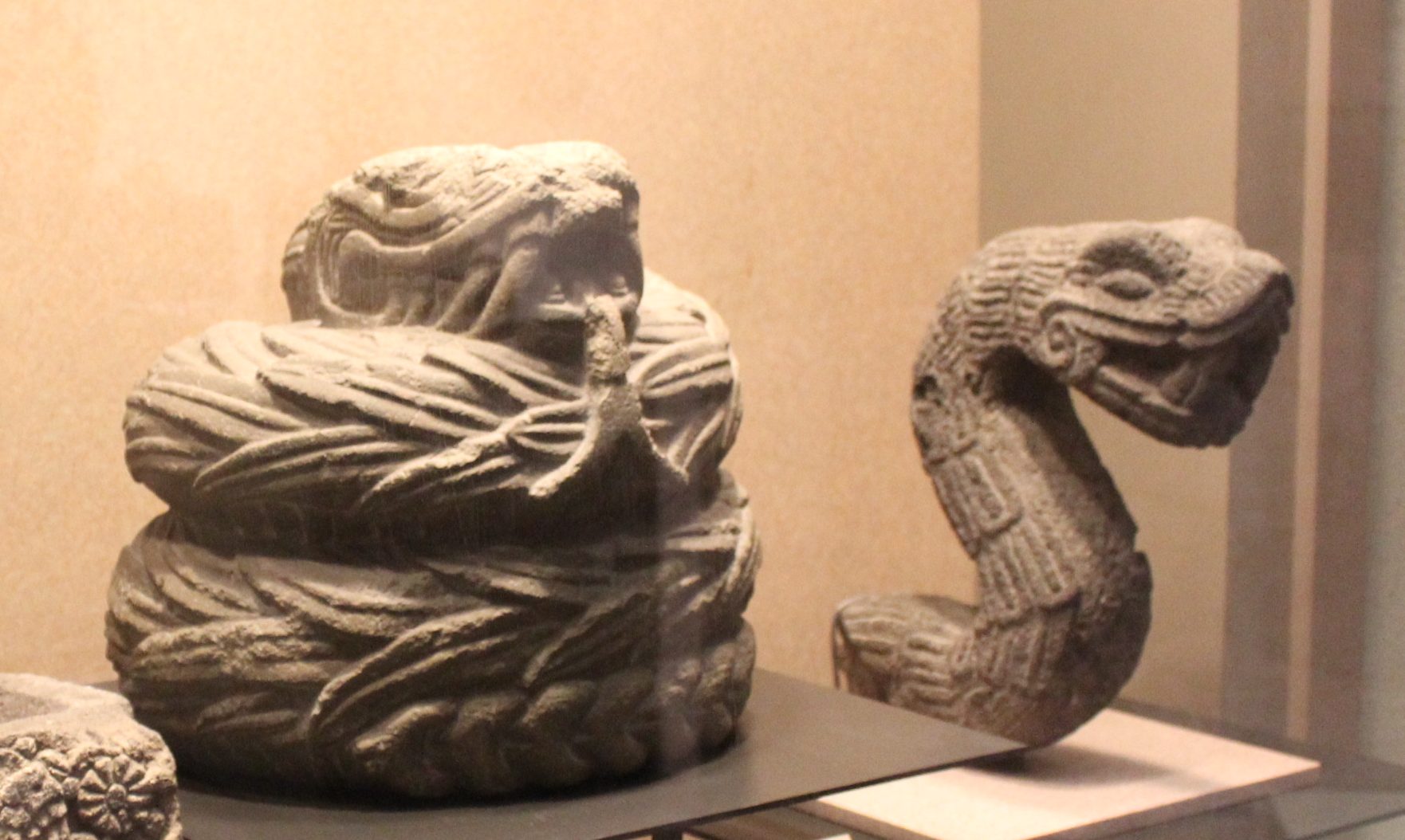
We are beaten and bruised by the sun as we walk up the central avenue, crossing a small river which flows under the avenue at right angles. There are low structures on either side of the avenue, half hidden amongst thorny bushes, cactus and aromatic trees.
“How old is all this?” I ask.
“It has a long history. It was built around 150 CE, and abandoned in the eighth century. It is not clear what happened, but at one point much of the site was burnt. It has been uninhabited ever since. But not unknown. The Aztecs used this place, as did the Toltecs who came before them. They respected the site and carried out rituals here. The Aztecs called this central axis the Avenue of the Dead.”
“And the Aztecs built Mexico City?”
“They built Tenochtitlan, on an island in the Texcoco lake, which is now the site of Mexico City. They had been there two hundred years when the spanish came.”
“So in Peruvian terms, the Aztec flourished around the same time as the Inca, who also met the spanish. But this site matches the early intermediate period, the times of the Moche and the Nazca.”
“You are very serious about this,” says Thelma. “What is your interest?”
I tell her briefly about the stones and the engravings at Cochineros, which seem quite insignificant compared to the elegant complex of giant stone pyramids around us.
“I am particularly interested in the continuity of this site, from the Teotihuacanos, to the Toltec and the Aztec. I believe, though I can’t yet prove it, that the first drawings were made on the stones in Peru at the time when these temples were being built, and the last were shortly after the coming of the spanish and the destruction that they brought.”
“In Maya terms, that is from Classic Maya beginning around 300 CE through to Chichen III and the last of the city centres at Mayapan, 1400 CE,” says Thelma.
“That means the stones at Cochineros were used for longer than the Maya cities in Yucatan.”
************************************************
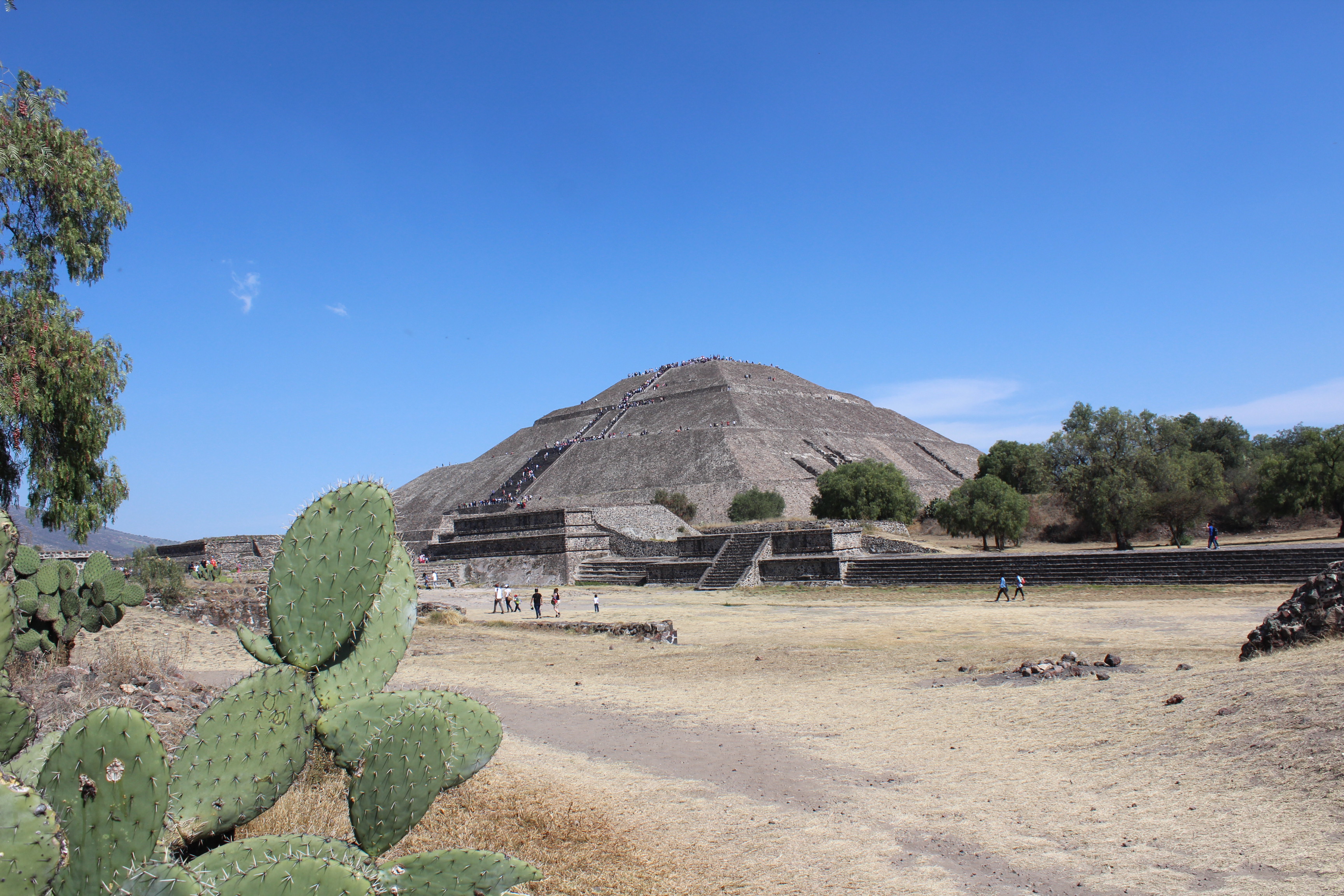
Together with dozens of tourists we climb the 248 steps of the Temple of the Sun, up and across four terraces before reaching the top platform. “They say it is 66 metres high but it feels like a lot more,” says Thelma.
The sides we see are made of of rough cut stone with protruding blocks, but Thelma tells me it was once coated in lime plaster and decorated with brightly coloured murals, perhaps like those of Bonampak, some of the best preserved in Mesoamerica.
From the flat top we look out over the site. I realise that these pyramids rising above the avenue mirror the volcanic peaks rising around the edges of this valley. I can also see that there is a massive complex of buildings around the site.
“The pyramids dominate the view from ground level,” I say to Thelma, “but from up here it is more like looking down on a city.”
“They say that 150,000 people lived here,” she replies. “On either side of the avenue were family homes, plazas, and workshops for potters, jewellers and obsidian workers.”
“In simple terms, I could describe this as a flat topped pyramid,” I observe. “In coastal Peru, we call them platform mounds. And there is a staircase up the front of it. In Peru, at Pachacamac and elsewhere, they are called pyramids with ramps. They are very similar structures.”
“The architectural style here is seen at Mayan sites in Yucatan and Honduras, and Mayan inscriptions refer to a ruler of Teotihuacan taking control of city-states such as Tikal in Guatemala, a thousand kilometres away. But from here to Pachacamac is more than four thousand kilometres.”
“I am just thinking aloud. I am not suggesting people from Teotihuacan travelled to Pachacamac and built ramped pyramids. But ideas travel faster than people, faster even than trade goods. This architectural form has spawned imitations.”
“Parallel evolution. If you want to be seen by lots of people, you need a raised stage, a theatre, an arena. A superbowl. Jennifer Lopez and Shakira. And if you want to control access, you have a single narrow stairway. I believe your queen waves to people from a balcony.”
“OK. The structures of power are universal. And clearly here we are seeing that. But the queen, the pope and Shakira enter backstage.”
“The consensus is,” replies Thelma, “that the staircase was for taking up prisoners who would be sacrificed on top. Of course the people want to see that.”
“That is interesting. Of course I have heard of such practices amongst the Maya and the Aztec. I wonder if the same applies to the Ychsma ramped pyramids.”
***************************************************************
Back on the avenue, we head towards the Pyramid of the Moon. Along the main street, the roadway of the dead, are vendors of gifts. They wear broad brimmed hats, and offer bows and arrows, ceramic skulls, obsidian mirrors, turtles inset with turquoise eyes, and whistles that sound like a piping bird or the roar of a jaguar.
I want an obsidian knife blade, shaped the old way by punching off flakelets, and find it in the shade of a stepped temple, in the basket of a vendor wearing an official Machu Picchu guide’s jacket.
I buy my blade, dark and beautiful, despite a crude green plastic handle, and we have a look at the other beaded bracelets, silver pendants, and crystal pyramids without much interest.
“Wait – I have something special,” he says in Spanish.
“You know about the energy in this place, the energy of the stones. Watch.”
He takes a polished black and gold sphere out of his backpack, places it on a similar polished saucer on the ground, and sets it spinning.
“Now, rub you hands together to create energy, and put your hand on it.”
I put my palm on the ball and it stops spinning.
“No, don’t touch, just put your hand above.”
He sets the orb spinning again and as I place my hand over it, it rotates faster. I raise my hand, and it slows.
“You try” he says to Thelma, and I watch carefully. Sure enough, as she lowers her hand, the sphere spins faster. As she raises her hand, it slows down again.
“It is a special stone” he says, “that we dig from round here. But it will work anywhere, even in Peru.”
In any case, I have to have this, and I offer 200 pesos. “No, for this, it is not cheap like the other things…”
Eventually I pay 500 pesos – maybe $25. As we make to leave he says “One more thing. You have to keep it clean. Every thirty days you must wash it in sea water, if you can, or at least salt water. You have to purify it, to remove the contamination. Remember, wash it in sea water every thirty days!”
************************************************

Walking along the Central Avenue towards the Temple of the Moon we climb up and over a series of stepped structures, which appear like the dam walls of a chain of ponds. Low tunnels, which a small child could crawl through, pass through each of these dams. Drainage channels roofed with stone pass along the avenue on either side.
“I feel as if we are walking along the bed of a dry canal, through empty reservoirs,” I comment to Thelma.
“You may be right,” she replies. “There is evidence that they flooded this area at times. Then the pyramids would stand as mountains above a lake or the sea, symbolic of rebirth after a flood. For me, the pyramids are rounded pregnant wombs.”
Thelma is a woman without children, and thirty-five years old. For me, the pyramids are volcanic cones, like those we see in the landscape around us. But of course they could be both.
“The truth is the people who built this place moved on, and we are still learning about it,” she says. “The Sun and Moon labelling is random European-based nineteenth century archaeological thought. Everything was sun and moon in those days.”
“We have the same in Peru, near Trujillo. Two great ransacked mounds of adobe. The spanish diverted a river to undermine the sides of one in search for gold. They are called la Huaca del Sol and la Huaca de la Luna.”
“The Aztec called this the avenue of the dead, because they though these were tombs. But in fact they were temples. The so called Pyramid of the Sun was a temple of the water god Tlaloc or the god of death. The latest interpretation is that they were focused towards water, fertility, death and renewal.”
“Flooding the site would fit with that.”
“Artefacts, wall paintings and analysis of bodies all suggest that the city was inhabited by peoples from across Central America, with Maya, Zapotec, Mixteca and more,” says Thelma. “This was a multi-ethnic metropolis.”
” The Inca did something similar, ” I observe. “Cusco was a city which brought together people from across the Inca empire. And not by accident but by design. The Inca brought them to the city, gave them a district, a barrio to live in, and asked them to wear their own distinctive headgear to identify their origin.”
“The Aztec built a powerful trade network across much of central America. They controlled a valuable natural resource – obsidian.”
“The Inca centrally managed the distribution of goods, rather than using trade and market forces, but they used all the different capabilities of their empire, and their allies. Fish from the coast, maize and beans from the valleys, potatoes and llama meat from the highlands. Without such trade or alliances some people live entirely on fish, and other eat only potatoes.”
“But today some countries have leaders who want to restrict trade and eject foreigners,” says Thelma.
“It is the last desperate throw of a failing civilisation, I suspect. Perhaps the Maya or the Aztec did something similar, towards the end. Crops are failing, weather patterns have turned destructive, so the leaders seek someone to blame.”
“The Maya, or the Muslims, or the Poles.”
*************************************************

Continuing to the northern end of the avenue we reach the Pyramid of the Moon, standing below a mountain which parallels its form. The view across this city of pyramids in a plain is a mirror of this central Mexico landscape, where the cones of ancient volcanoes rise above the plateau.
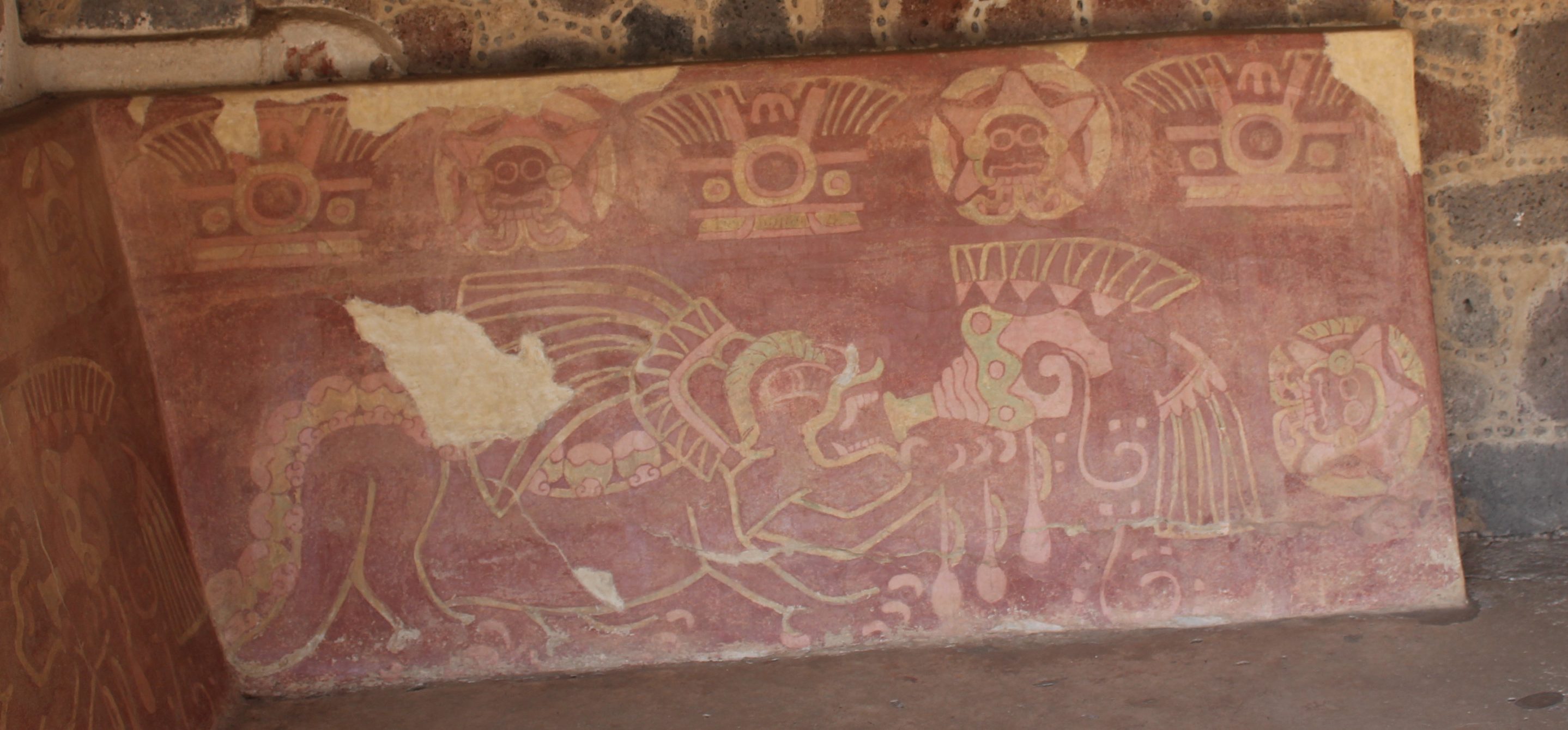
We enter a group of buildings on the left, with carved columns and painted plasterwork, known as the Palace of the Jaguars. It may have been the residence of a priest. The fine murals show a repeated motif painted in green and red of a parrot holding flowers and water, and in the next temple, the jaguar god blowing conch shells and praying to the rain god.
I am particularly intrigued by the conch shell held by the jaguar god.
“I have seen that before,” I tell Thelma. “The drawing of the conch has a spiral and steps. In Peru this was a symbol for many cultures, over thousands of years. It is said to represent the sea and the mountains.”
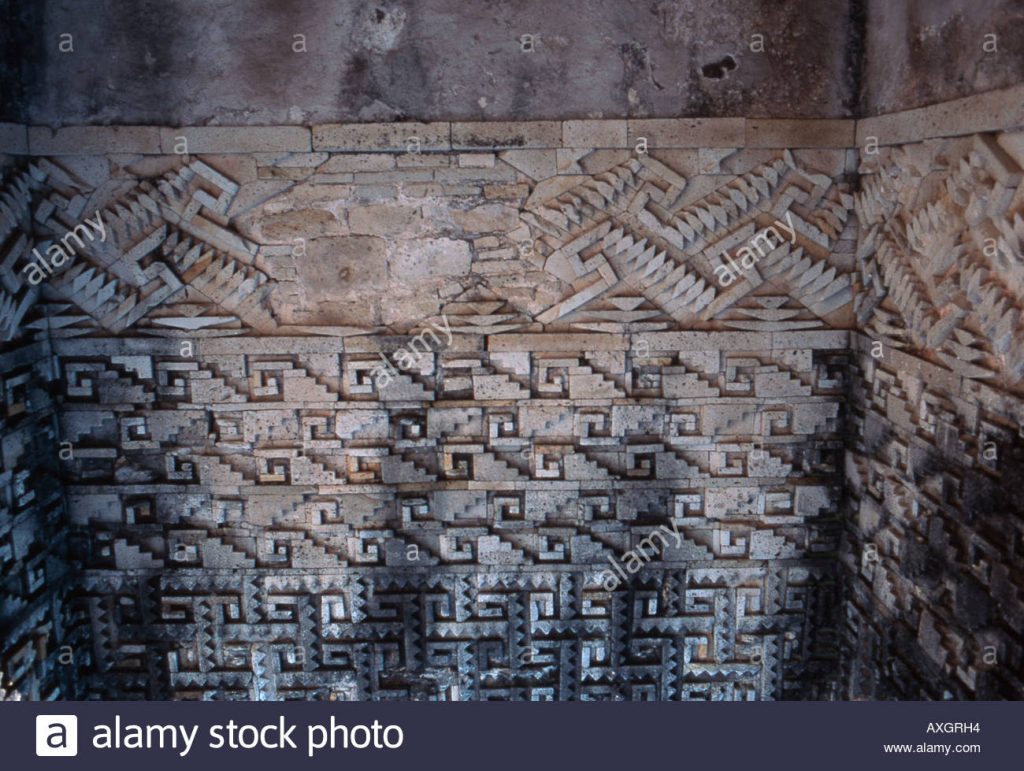
“It is well know here in Mexico too. The step-fret motif dominates Maya buildings at Mitla. It even has a name. It is called Xicalcoliuhqui.”
*******************************************************
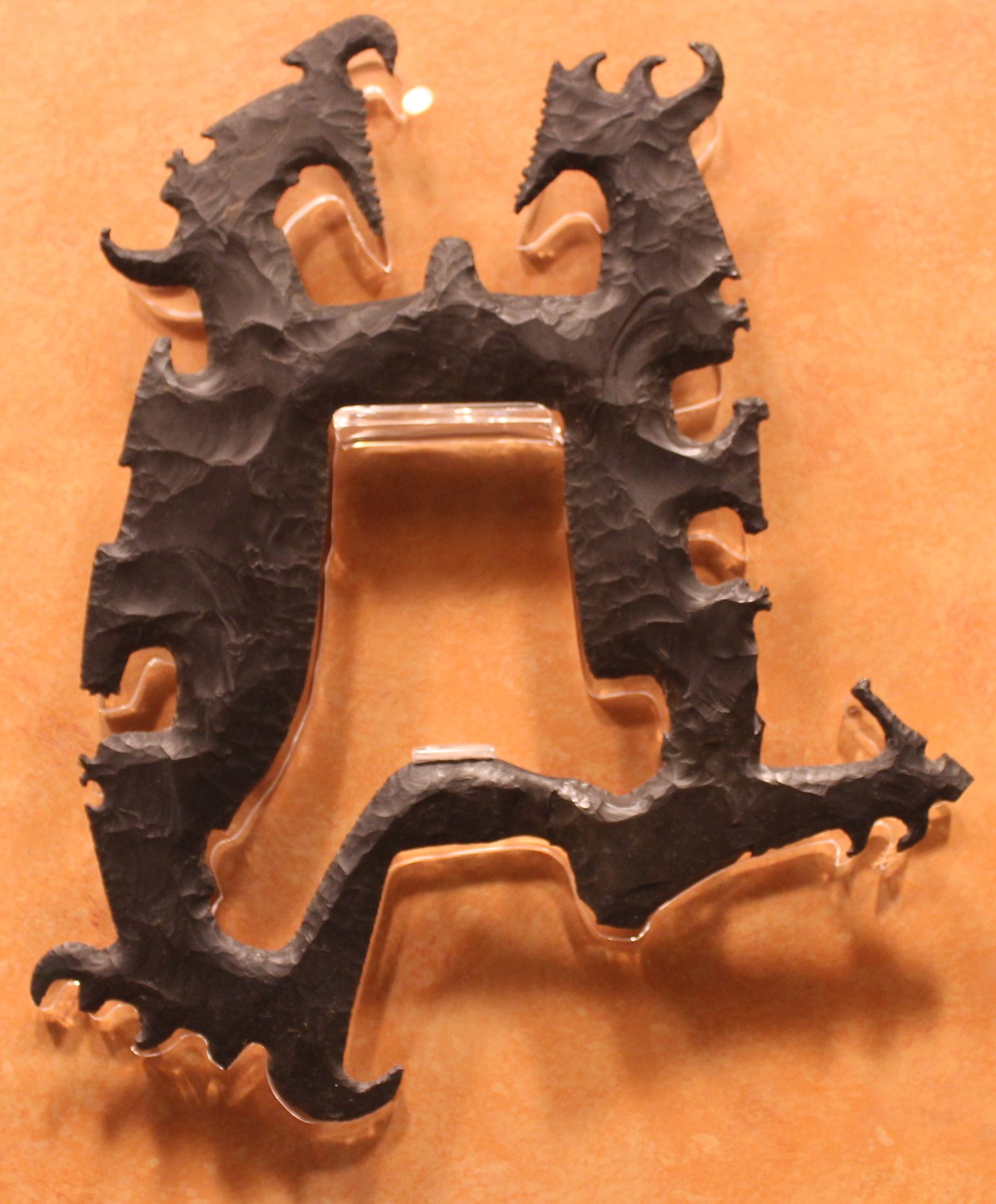
The Mexica, who gave their name to the future city and country, formed part of the alliance which dominated the valley. Wars were fought, ritualistically, to obtain prisoners for sacrifice to the gods. The city built on an island in a lake was the centre of an empire which traded across Central America. The area supported more than a million native people. Ninety percent died within 100 years of the spanish arrival.
These deaths were due in part to an epidemic which spread through the common population. “It became such a great pestilence among them throughout the land that in most provinces more than half the population died; in others the proportion was less,” according to Toribio Motolinia, a spanish monk that witnessed it. “They died in heaps, like bedbugs.”
The same happened on the islands from where the spanish launched their invasion of Mexico. Large islands such as Cuba and Hispaniola may have had populations of several million before the invasion. But in 1574 a census in Hispaniola documents 1000 spanish and 12,000 African slaves. The indigenous Taino are all gone, eighty years after the spanish first set foot on the island.
11**********************************************
N. says on 10th December 2017.
“The strategy has been one of domestication of the Peruvian people, to make them easy to control. But what puzzles me is that, farmers normally want to choose their livestock to be of the best quality, to breed in the best features. But here in Peru, domestication is directed towards the lowest standards of ignorance. Why would they want to do that?“
N. was on the Black List of the Sendero Luminoso terrorists. “One morning I opened the newspaper to see my name on the list of people the Sendero Luminoso were intending to assassinate.”
This was because she worked with overseas aid agencies (ONGs).
She had previously been sought out and questioned by government investigators who suspected her of supporting and financing terrorism.
This was because she worked with overseas aid agencies (ONGs).
12*********************************************
December 10th 2017. video of the allanamiento, the search by fiscals three days earlier, reveals several Fujimorista congressmen in the building with the fiscals. Ursula Letona and Ariana Aramayo follow the fiscals round the building filming on their i-phones, Luz Delgado is heard to say “you don’t know who you are messing with”.
December 15th 2017. The Fiscal reports nine Fujimorista congressmen for “violence against authority by impeding the fiscal in the execution of his duty” saying there were “constant acts of intimidation”. The congresistas include Rosa Bartra, Luz Salgado, and Hector Becerril.
13******************************************
December 15th 2017. Congress discusses a motion of Vacancia of the Presidency, on grounds of “moral incapacity”.
The notice of the introduction of the motion is posted at 1 pm and the debate is scheduled for 4 pm. The motion is passed at 10 pm.
Congress can remove the President if 87 members vote for vacancia. 93 members – 71 from Fuerza Popular, 9 from Accion Popular, 5 from Apra, 10 from Frente Amplio, support the move to debate the vacancia and the president will have 60 minutes to present his defence, the following Thursday.
December 17th 2017. At 8 pm the President invites five journalists to the palace to interview him live on TV for 40 minutes. He says he was in effect the owner of a bank where other people did various financing activities on which he took a commission. He did not oversee nor was responsible for exactly what they did and his commision was of the order of 5 or 6%. One journalist asked repeatedly how he could prove that he had not profited from Odebrecht activities. “This is what people want to know”.
December 18th2017. Press coverage of the overnight interview is largely negative. Headlines include “The dream is over” and “He is on the way out”.
December 19th2017. The President’s lawyers ask Congress to state what he is being accused of. The Defender of the People says that due process and legal rights to a fair trial apply equally to trial by congress as trial by a judge. Several commentators talk of “due process” and “innocent until proven guilty.”
Hector Becerril says Fuerza Popular has already decided to vote for vacancia and does not need to hear any more. Spokesmen for Apra and Accion Popular says they will vote for vacancia.
Luz Salgado is outraged about something or other. “Who do they think they are? We’ll show them fried garlic!”
December 21 2017. The vote to impeach the President must be taken by two thirds of Congress, 87 votes out of 130. Fuerza Popular which has called for him to go has 81 votes, and its informal allies in Apra have a further 5. Accion Popular has promised its five votes for impeachment. Several other parties have indicated they intend to oust the President.
There is a long debate, most noteworthy for the intellectually and morally rigorous defence of the President by lawyer Alberto Borea. For the most part calm, this sixty year old man nevertheless shakes with fury as he described some of the abuses of the 1990s, such as when he had himself fought to stop the illegal third term of Fujimori.
Then to general surprise Kenji Fujimori, brother of Keiko and at times her open rival, leads a rebellion of ten FP Congressistas who abstain. PPK survives the impeachment by a handful of votes.
14******************************************
December 24th2017. At 6pm as most Lima families are preparing to eat together, President Pedro Pablo Kucynski announces that he has given an indulto, a pardon, to the imprisoned former President and ex-dictator Alberto Fujimori. A recommendation on the basis that he suffered from a “grave, worsening, illness” came from the panel of three doctors.
That night, towards midnight, a crowd gathers in the Plaza de San Martin, the Liberator, the traditional gathering point for demonstrations.
25 December 2017. Alberto Belaunde, who had said the previous day that he would resign if there was a pardon for Fujimori Senior, announces his resignation.
Vice-President Mercedes Araoz had said during the debate on the motion for vacancia, “we do not negotiate on a pardon.”
Meanwhile, it would appear, ten FP members voted against the vacancia because they had been promised a pardon.
After PPK defended himself against a charge of “permanent moral incapacity”, within 72 hours he demonstrates to his remaining supporters that he is in fact, guilty of “moral incapacity”, in releasing after only ten years the man who Transparencia International listed at the seventh most corrupt dictator of his decade. The man who has stolen an estimated $600 million from Peru, and has been sentenced to 25 years imprisonment for a few sample crimes with several other cases pending.
Alberto Borrea, the lawyer who defended PPK, declared that he had no knowledge of the coming pardon and the subject had never been raised.
Former Minister Pedro Cateriano says “I am profoundly sorry and condemn the treachery against democracy and human rights committed by the President. The pardon for the dictator is not a humanitarian act, it is an appalling political deal.”
Juan Sheput of the PPK party Peru for Change says that the party was not involved in the decision to pardon Fujimori. “We came to the palace to be told of PPK’s decision. We were not consulted and we are not responsible.”
And a Happy Christmas to Peru.


